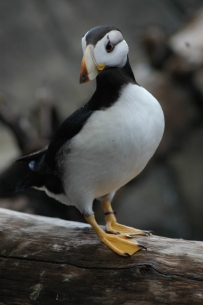Alaska Species Explorer
All
x
- – No known individuals remaining.
- – Known only to survive in captivity, or as a naturalized population outside its historic range.
- – Extremely high risk of extinction in the wild.
- – High risk of extinction in the wild.
- – High risk of endangerment in the wild.
- – Likely to become endangered in the near future.
- – Lowest risk. Does not qualify for a higher risk category. Widespread and abundant taxa are included in this category.
- – Not enough data to make an assessment of its risk of extinction.
- – Has not yet been evaluated against the criteria.
Horned Puffin
- – No known individuals remaining.
- – Known only to survive in captivity, or as a naturalized population outside its historic range.
- – Extremely high risk of extinction in the wild.
- – High risk of extinction in the wild.
- – High risk of endangerment in the wild.
- – Likely to become endangered in the near future.
- – Lowest risk. Does not qualify for a higher risk category. Widespread and abundant taxa are included in this category.
- – Not enough data to make an assessment of its risk of extinction.
- – Has not yet been evaluated against the criteria.
Ngaq'ngaaq
The species is widespread in the North Pacific Ocean. It nests on coastlines and offshore islands from British Columbia (where they are rare) to Alaska, and southwest to the Sea of Okhotsk and the Kuril Islands. In Alaska, the largest colonies are concentrated in the northwest Gulf of Alaska and along the Alaska Peninsula in the Semidi, Shumagin, and Sanak islands. The horned puffin population is estimated at 1.2 million.
Although information on population status is very limited, boat based surveys of seabirds at sea in Prince William Sound, Alaska, suggest an overall 79% decline of Horned Puffins from 1972-1998. Considering the large-scale changes in marine food chains and climate which have been observed over the last decade, prey availability is the most likely source of population regulation.
Horned puffins are monomorphic; the male and female exhibit the same plumage coloration. In summer, it has a small, fleshy, dark "horn" above each eye from which it takes its name, and brightly colored orange and red bill. Outer layers of the bright bill are shed in late summer, leaving a smaller, drab colored bill. During the winter the legs and feet fade to a pale fleshy color and the face is a shade of grey and black.
Herring, capelin, sandlance, anchovies, rockfish, and sculpin and some invertebrates, such as shrimp and krill.
Habitat preference includes cold ocean waters, sea cliffs, and rocky islands, and grassy bluffs. This species is pelagic, living on the open sea for majority of its lifetime. During the non-breeding season (juvenile years and adult winters), this species is found throughout the waters of the north Pacific. They nest in crevices and burrows on sea cliffs.
- Because of its coloration it was named “sea parrot” and “clown of the sea” by early sailors
- Able to catch and secure more than one fish by using spines on their tongues and roofs of their mouths. Can carry up to 80 sand eels back to nest to feed their chick.
- Congregate in the winter in large groups called "rafts".














